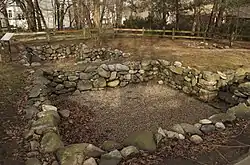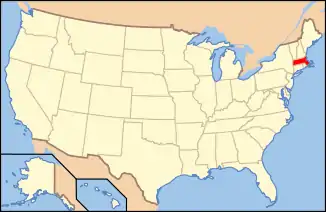Salem Village Historic District | |
 Archeological site of the Salem Village Parsonage, where in 1692 the witchcraft hysteria began when a slave from the Caribbean named Tituba spread tales about witchcraft to the Puritans. | |
  | |
| Location | Danvers, Massachusetts |
|---|---|
| Coordinates | 42°34′0″N 70°57′38″W / 42.56667°N 70.96056°W |
| Built | 1681 |
| Architect | Mudge, Josiah, et al. |
| Architectural style | Greek Revival, Colonial, Federal |
| NRHP reference No. | 75000252 [1] |
| Added to NRHP | January 31, 1975 |
The Salem Village Historic District encompasses a collection of properties from the early center of Salem Village, as Danvers, Massachusetts was known in the 17th century. The district includes an irregular pattern of properties along Centre, Hobart, Ingersoll, and Collins Streets, as far north as Brentwood Circle, and south to Mello Parkway.[2] It includes several buildings notable for their association with the 1692 Salem witch trials, which were mostly centered on individuals who lived in Salem Village. Included in the village are the Rebecca Nurse Homestead, now a house museum, and the remains of the local parsonage, both places of relevance to the witch hysteria.[3]
The Town of Danvers, Mass., voted at the Annual Town Meeting on March 18, 1974 to establish this area as a local historic district regulated by a Historic District Commission, in order to preserve the historic structures and their architectural features.[4] The district was then listed on the National Register of Historic Places in 1975.[1]
Map of the District
See also
Further reading
Gagnon, Daniel A., A Salem Witch: The Trial, Execution, and Exoneration of Rebecca Nurse. Yardley, PA: Westholme, 2021.
References
- 1 2 "National Register Information System". National Register of Historic Places. National Park Service. April 15, 2008.
- ↑ "Map of the Town of Danvers Salem Village Historic District". Town of Danvers, Mass. Retrieved June 14, 2023.
- ↑ "Salem Village". National Park Service. Retrieved January 13, 2014.
- ↑ "Historic District Commission". Town of Danvers, Mass. Retrieved June 14, 2023.
